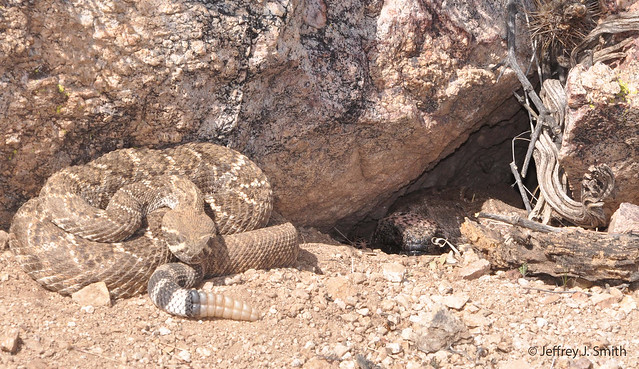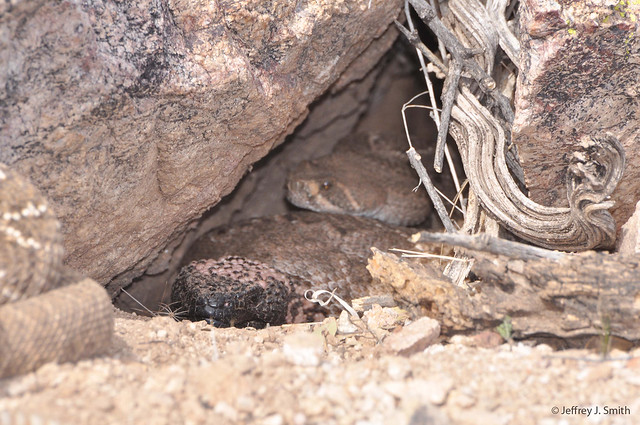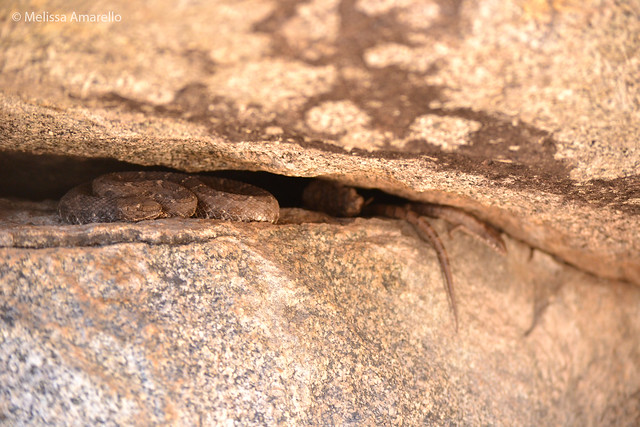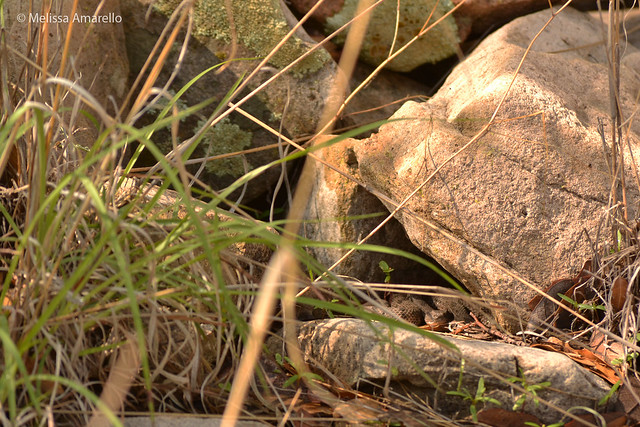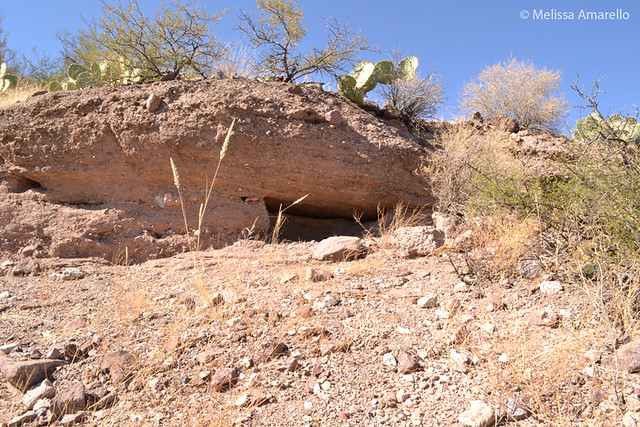In February of 2010 we discovered a number of rocky refuges used by western diamondbacks to spend the winter. These sites are treasured by generations of snakes for the protection offered from freezing temperatures, an arrangement of safe basking locations, and, perhaps, a rock surface that funnels a sprinkle of rain into a drinkable collection.
In mid-February of 2011, we visited to this area again to find that snakes had returned to most of these sites. One spot, in particular, intrigued us. Whereas last year it was found to house but one snake, it now contained several, perhaps even five snakes. We call it Bandshell, and it’s a small eruption of rock from the hillside with a deep, nearly vertical crevice into an inverted rock face.
We mounted a timelapse camera near the face of Bandshell in hopes that we would see how many snakes used this den this winter and perhaps get a glimpse of some emergence (‘egress’) behavior. We were more successful than we could’ve imagined.
25 February – 2 March 2011
With the exception of a weak storm front moving through on the 27th, the cameras record only a lack of activity by the snakes.
3 March 2011
Two young males, Scarecrow (S) and the Tin Woodsman (T) make their film debut.
These snakes engaged in combat, a ritualistic wrestling match whose outcome depends on which snake is better able to hold its opponent to the ground while intertwining. The victor may then be left to court a contested female.
Later that day, we return to swap data cards in the camera. About 5 m downslope of the den, we find T, stretched out amid brush and rocks. We are careful not to disturb him.
T enters the den at 1630, and S follows a quarter hour behind.
4 March 2011
A near repeat of yesterday. S slides out first with T following close behind.
This time, however, S appears reluctant to engage in combat.
T returns to the den at 12:48.
(Because of higher temporal resolution, the camera shuts off at 13:20 on 4 March)
6 March 2011
We arrive at 1000 and exchange memory cards. No snakes are evident outside the den.
T emerges and hangs around den.
S enters the den later that afternoon.


7 March 2011
Only T is active.
8 March 2011
T emerges, returns to the den, reemerges.
9 March 2011
No snake activity recorded.
10 March 2011
The warmest day so far this year brings some fresh characters.
The Cowardly Lion (C), a much larger male, emerges.
A female, Dorothy (D), emerges and coils at the entrance of the den.
T emerges and courts D. If you look carefully, courtship appears to continue just out of the frame in the upper left. At 1318, S emerges from the den, approaches the pair offscreen, and, apparently engages T in brief combat.
C crosses the frame.
T checks on the den.
C emerges from the den. S is not far behind.
T crosses the frame
A second female, Auntie Em (E), emerges.
We return to swap cards, but cannot do so without disturbing snakes around the den, so we postpone. E is still coiled at the entrance of the den.
S flanks the other side of the camera, about 2 m NE of the den entrance.
C returns to the frame to court E.
We return to find that S has vacated his post, and we take a chance on disturbing C and E, switching memory cards in the camera mostly hidden from their view. Although E is facing away, she appears to take a cue from C, who enters the den shortly after our departure.
About 20 m below the den, T sits in coil.
12 March 2011
The camera is now set to begin at 0800 rather than 0900, capturing the emergence of C.
E emerges and is soon joined by C.
At this point, the camera mysteriously shut off for 24 hours.
13 March 2011
E is visible coiled in the shade. C enters and courts her for 90 minutes, alternately chin rubbing and resting out of contact with her. Several times, as C rests, E moves her head slightly and appears to prompt him into another round of chin rubbing (e.g., at 14:58, 15:13, 15:28, 15:49).
14 March 2011
C is already out basking when the camera activates at 0800.
Later, T and one of the females emerge and interact. C returns, and the other snakes return to the den. C monitors then den, and at 09:53 E emerges, followed by T (10:05). E appears to be trying to re-enter the den as T vigorously courts her.
With E or T visible in the entrance to the den, C comes back and checks on the den several times., finally coiling in the shade to the left of the den entrance.
The next 90 minutes are obscured by the high contrast between areas in sun and shade, but at 12:24 the snakes are visible, with C out front, E (below) and T (above) in the den entrance.
15 March 2011
The only activity on this day is C posting up at the den entrance for a bit.
16 March 2011
Again, C is the only snake caught in the frame today as he checks on the den.
17 March 2011
A new snake, Oz (O) checks on the den. We think this snake overwintered at a different site.
18 March 2011
C checks on the den.
19 March 2011
Camera is taken down at 1000. Just a few meters downhill from the den, we discover E and C copulating.















